The concept of symmetric space is of central importance in many branches of mathematics. Compactifications of these spaces have been studied from the points of view of representation theory, geometry, and random walks. This work is devoted to the study of the interrelationships among these various compactifications and, in particular, focuses on the Martin compactification. It is the first exposition to treat compactifications of symmetric spaces systematically and to uniformize the various points of view. Key features of this volume include: a definition and detailed analysis of the Martin compactifications. a new geometric compactification, defined in terms of the Tits building, that coincides with the Martin compactification at the bottom of the positive spectrum. a geometric, non-inductive, description of the Karpelevic compactification. a study of the well-known isomorphism between the Satake compactifications and the Furstenberg compactifications. a systematic and clear progression of topics from geometry to analysis, and finally to random walks. The work is largely self-contained, with comprehensive references to the literature. It is an excellent resource for both researchers and graduate students. Series: Progress in Mathematics, Volume 156 Contents: Preface Chapter I. Introduction Statement of the main results Characterizations of the compactification X SF The Karpelevic compactification X K Fibers of maps between the compactifications Application to Brownian motion Eigenfunctions and the Martin method Methods of proof Open problems Conventions Study guide Chapter II. Subalgebras and parabolic subgroups Iwasawa and Cartan decompositions Parabolic subgroups Subsets of Delta and Lie subalgebras The Langlands decomposition of P I and the symmetric space X I Bruhat decompositions Chapter III. Geometrical constructions of compactifications The conic compactification X c The conical decomposition of a and the Weyl group Parabolic subgroups and stabilizers of the points in X (infinity) Flats through the base point and Proposition 3.8 The Tits building Delta(G) of G and its geometrical realization Delta (X) The polyhedral compactification of a flat The dual cell complex Delta (X) The dual cell compactification X U Delta (X) Chapter IV. The Satake-Furstenberg compactifications Finite dimensional representations Weights and highest weights Representation and parabolic subgroups Satake compactifications Furstenberg compactifications Chapter V. The Karpelevic compactification The Karpelevic compactification Convergence in the Karpelevic topology restricted to a flat The Karpelevic compactification of a The Karpelevic topology is compact The relation between the Karpelevic, conical and dual cell compactifications A characterization of the Karpelevic compactification Chapter VI. Martin compactifications The Martin compactification Convergence of Brownian motion Extension of the group action to the Martin compactification The Martin compactification for a random walk Chapter VII. The Martin Compactification X U (partial)X (Lambdao) The Laplacian in horocyclic coordinates Generalized horospherical coordinates and the Laplacian Computation of the limit functions: reduction The limit of a CI -canonical sequence Classification of limit functions and the topology of X U (partial)X (Lambdao) Chapter VIII. The Martin compactification X U (partial)X (Lambda) The case of X = SL(n, C)/SU(n) for Lambda Lambdao Computation of the limit functions for a general semisimple group Determination of the Martin compactification Bounded harmonic functions on X An application to convergence of Brownian motion Chapter IX. An intrinsic approach to the boundaries of X The space of closed subgroups Limit groups Limits of group spheres Parabolic subgroups and boundary theory The maximal Furstenberg compactification Chapter X. The twisted action and compactification via the ground state The twisted action Compactification of X via the ground state Chapter XI. Harnack inequality, Martin's method and the positive spectrum for random walks Basic notations Cones with compact bases and the Harnack inequality Martin's method for a random walk The positive spectrum of a random walk The fixed line property Formulas for r (p), ro (p) Outline of the following chapters Chapter XII. The Furstenberg boundary and bounded harmonic functions Basic notations The mean-value property Harmonic functions and the mean-value property Convergence theorems for harmonic functions The Poisson formula for random walks Chapter XIII. Integral representations of positive eigenfunctions of convolution operators The main result of this chapter An extension of the main result Analytic determination of the minimal eigenfunctions of the Laplacian The Busemann cocycle and a geometrical determination of the minimal eigenfunctions of the Laplacian Minimal eigenfunctions for random walks Chapter XIV. Random walks and ground state properties Basic definitions and properties Spherical functions and minimal eigenfunctions Ground state properties Random walks, eigenfunctions of the Laplacian and X U (partial)X (lambdao) The Martin compactification of X determined by a random walk An application to parabolic groups Chapter XV. Extension to semisimple algebraic groups defined over a local field Some notations and fundamental properties Extension of the main results of Chapters XII, XIII, XIV Appendix A Compactifications of flats Compactifications of X The proof of Theorem 5.31 The topology of Delta (V) The topology of Hausdorff convergence on compact subsets The existence of N -left invariant solutions Convolution of measures A topological lemma Appendix B Furstenberg compactifications Some weight lemmas The structure of G . mQ The G -isomorphism of X S tau and G . mtau Bibliography List of symbols Index
Compactifications of symmetric spaces
Sobre
Talvez você seja redirecionado para outro site












